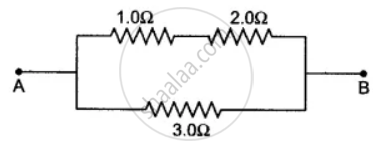Advertisements
Advertisements
Question
You are provided with three resistors of resistance 1.0 Ω, 2.0 Ω and 3.0 Ω How would you connect them to obtain the total effective resistance 1.5 Ω? Draw diagram of the arrangement and check it by calculations.
Solution

Two resistors of resistance 1.0 Ω and 2.0 Ω are connected in series and then this combination is connected in parallel with the resistor of resistance 3.0 Ω. The arrangement is shown in given figure alongside
Total resistance of series combination R = 1 + 2 = 3 Ω.
Total effective resistance of parallel combination
R = `(3 xx 3)/(3 + 3) = 1.5 Ω`
APPEARS IN
RELATED QUESTIONS
Find the expression for the resistors connected in series and write the two characteristics of it. (Draw figure).
Write any two characteristics of a series combination of resistors.
When a 4 Ω resistor is connected across the terminals of a 12 V battery, the number of coulombs passing through the resistor per second is:
(a) 0.3
(b) 3
(c) 4
(d) 12
How does the resistance of a wire change when:
its diameter is tripled?
What possible values of resultant resistance one can get by combining two resistances, one of value 2 ohm and the other 6 ohm?
The diagram below shows part of a circuit:

If this arrangement of three resistors was to be replaced by a single resistor, its resistance should be:
(a) 9 Ω
(b) 4 Ω
(c) 6 Ω
(d) 18 Ω
How will you oonnect five resistors, each of the value one ohm, to obtain an equivalent resistance of 0.2 `Omega`
Name the material of wire used for making standard resistances. Give a reason.
What material is used for making wire to prepare heating coils? Give a reason.
2Ω resistor A, 1Ω resistor B and 4Ω resistor C are connected in parallel. The combination is connected across a 2V battery of negligible resistance. Draw the diagram of the arrangement and calculate:
(i) The current in each resistor A and C,
(ii) The current through battery.
